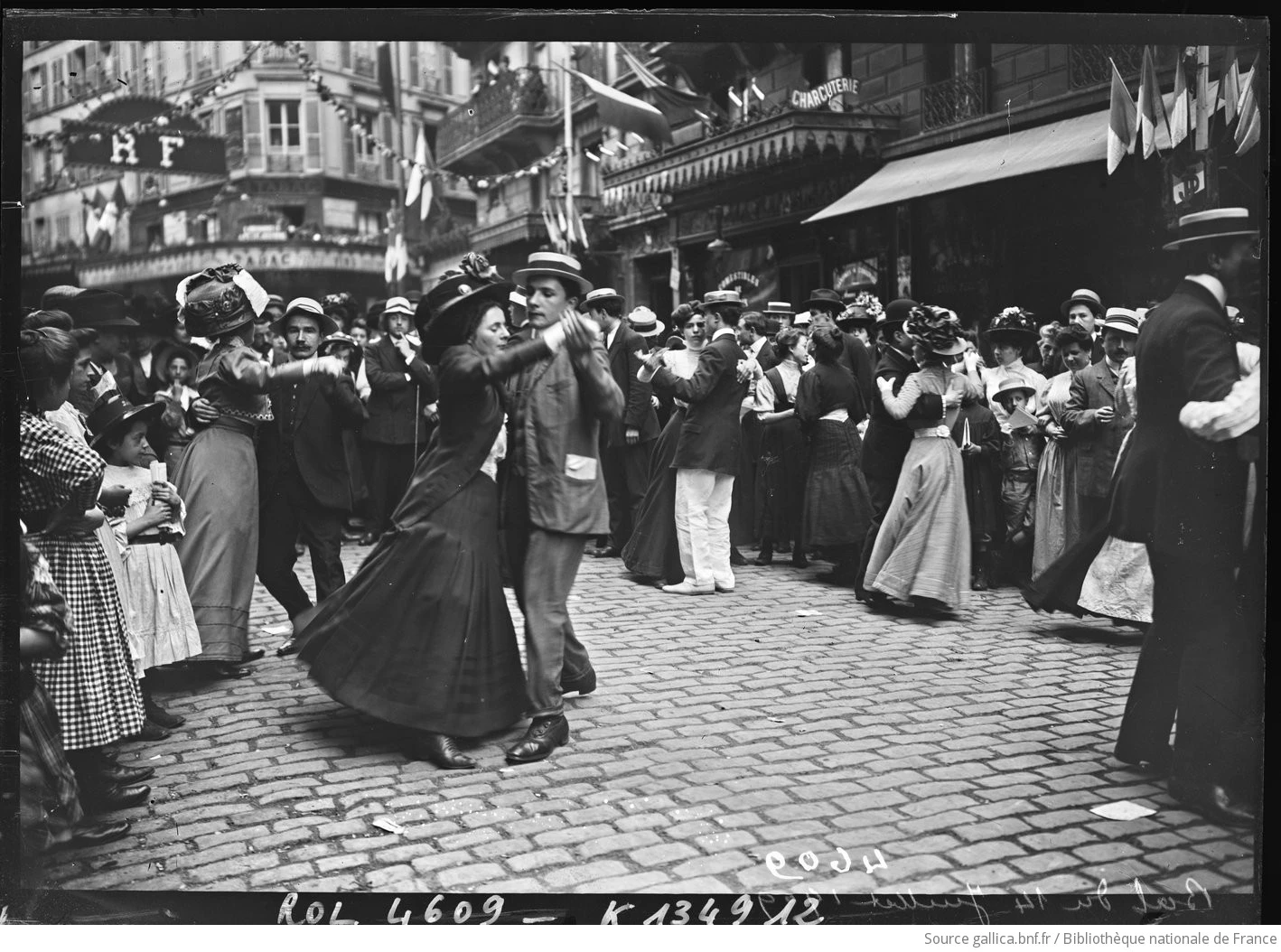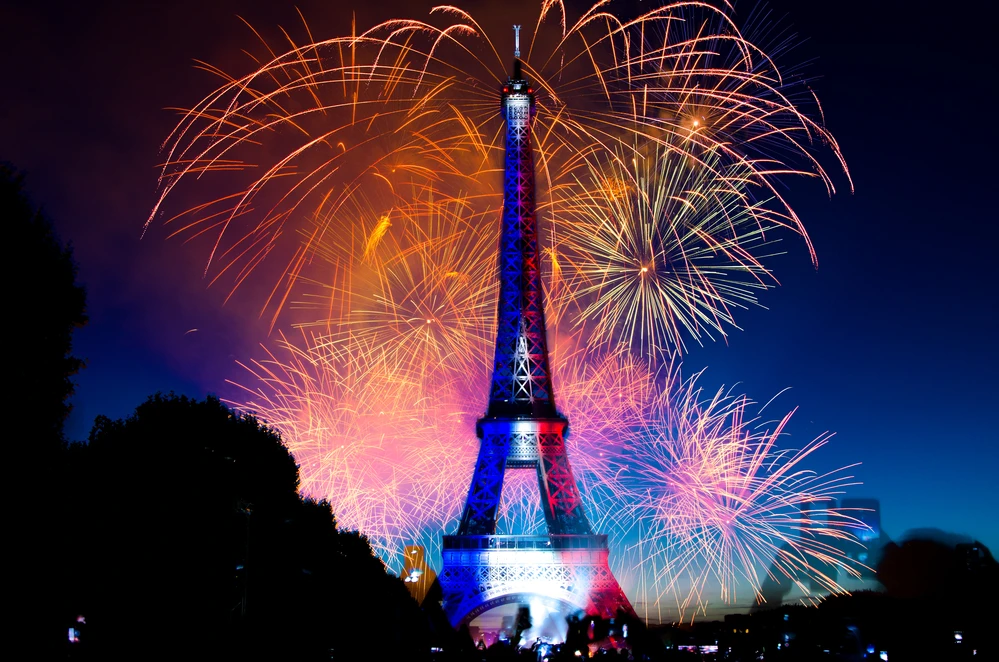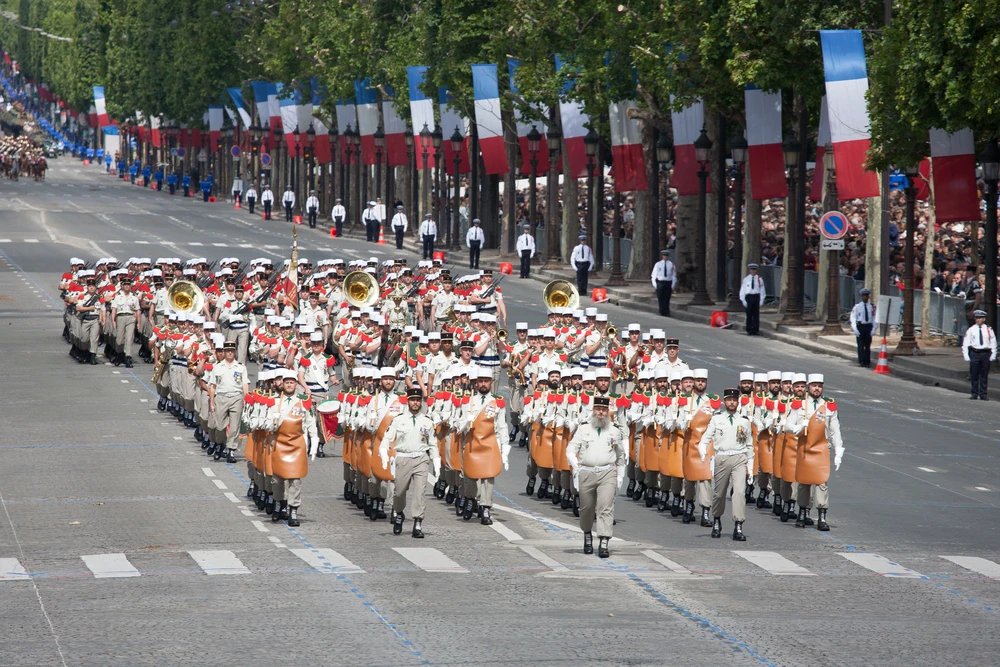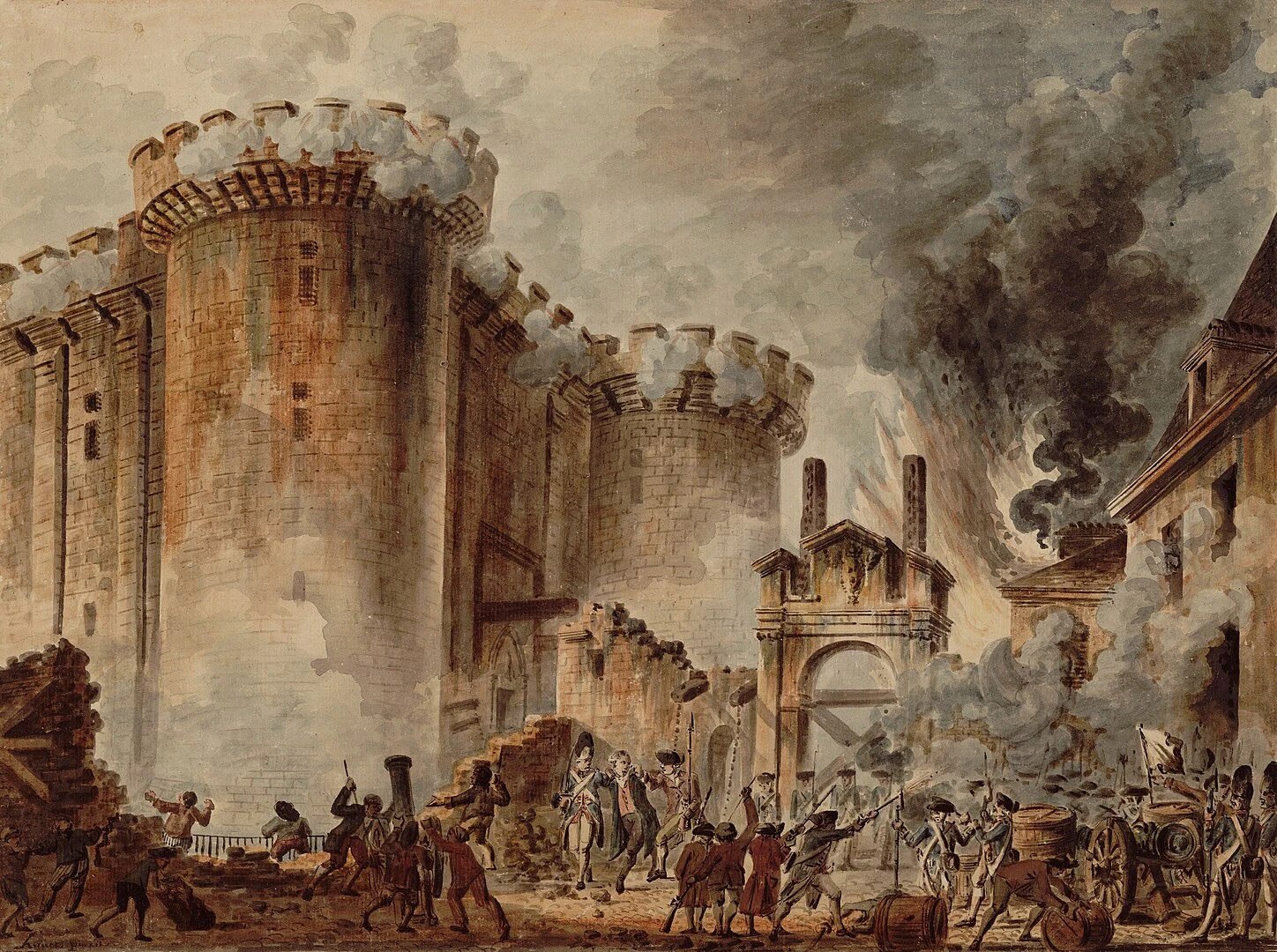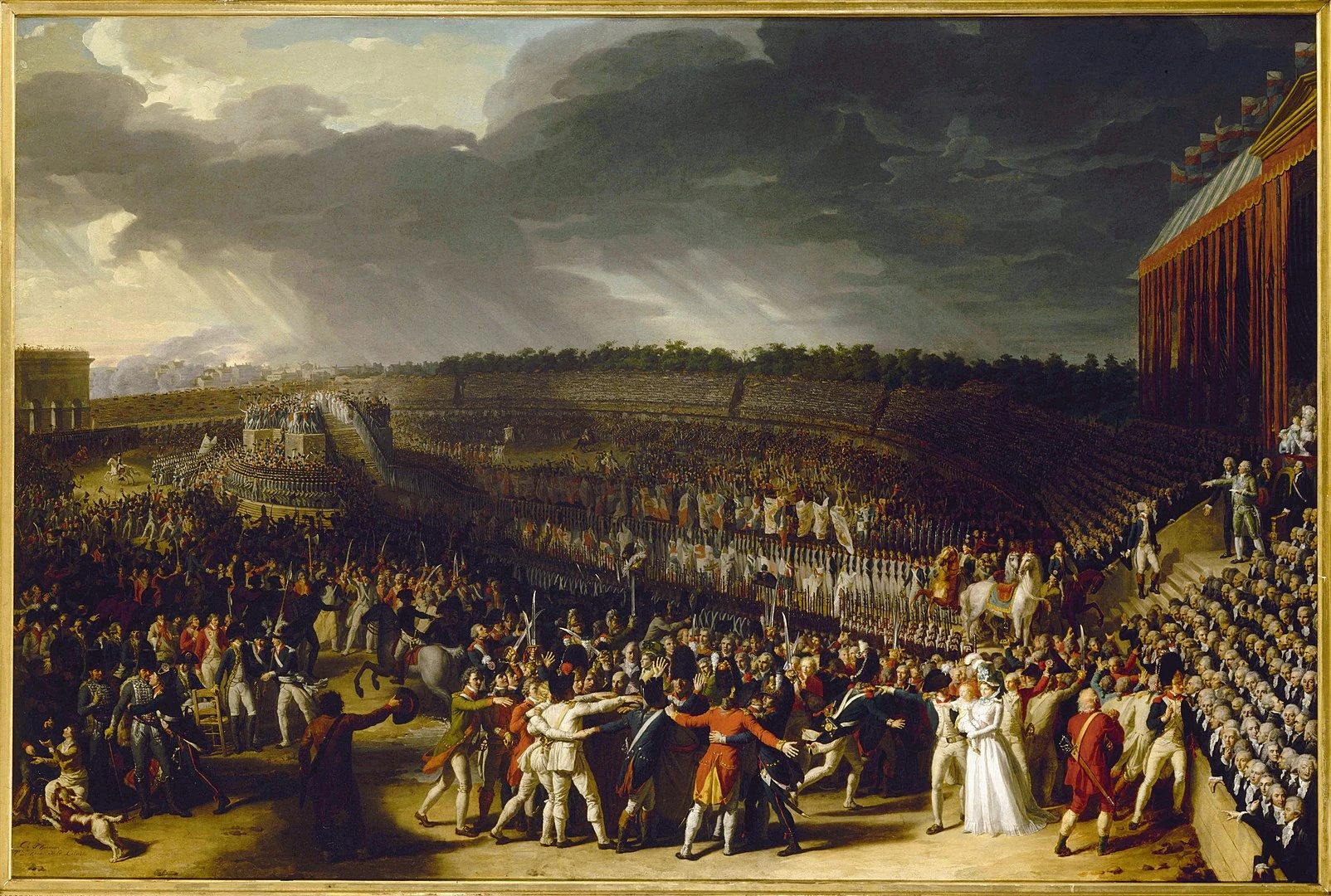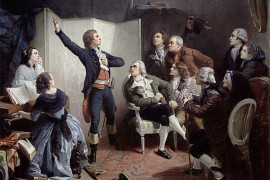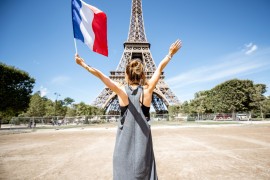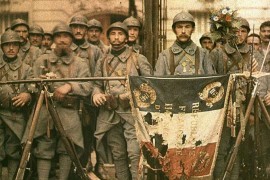Since when is July 14th a national holiday?
According to the Law, since July 1880, July 14 has been the national holiday. It says nothing else and makes no official reference to a particular July 14. It's not a commemoration. However, to push through the decision, the government of the time valorized the fête de la fédération of July 14, 1790 to convince deputies who found July 14, 1789 too bloody. Before this law, several days were more or less the national holiday. Under the ancien régime, Saint Louis was celebrated on August 25 (kings were descended from Saint Louis). During the French Revolution, the founding of the Republic was celebrated on September 22, from 1793 to 1803. Napoleon put an end to this and introduced Saint Napoleon's Day on August 15, 1806. Napoleon III reintroduced it in 1852. In 1880, La Républque reintroduced the July 14th symbol, all the more reason to do so since the date had been celebrated in secret by the Republicans under the Second Empire. It's been that way ever since!
It's traditional to pave town halls and public monuments on July 14th. Photo chosen by Monsieurdefrance.com: psnoiret@gmail.com via dépositphotos
Fireworks and popular balls: the traditions of the Bastille-Day
The July 14th 1909 ball in Paris. Source de Monsieurdefrance.com : Gallica.fr / BNF.
Fireworks and popular balls
It wasn't long before popular balls became an integral part of the national holiday. The town halls organize these balls, which are free of charge and therefore well attended. Discovered in France in the early 17th century, fireworks began to set the French sky ablaze in the late 19th century. As time went on, so did the custom of singing the Marseillaise as the fireworks were launched. The final bouquet is also part of the show.
Eiffel Tower fireworks since 1888
The largest fireworks display is fired from the Eiffel Tower above the Champs de Mars where the Fête de la fédération took place on July 14, 1790. Photo chosen by monsieurdefrance.com krys500 via depositphotos
In recent years, drones have sometimes replaced rockets. Since 1888, the biggest bonfire has traditionally been fired in Paris, on the Champ-de-Mars, from the Eiffel Tower. With few exceptions, there are several hundred thousand people to see it. (like in 2024, where there will be no crowds for Olympic security reasons).
Interview with the President, Legion of Honor...
It was Valery Giscard d'Estaing (1926-2020) who inaugurated the July 14th interview in 1978. It's not always up to date. Nicolas Sarkozy gave it up during his term of office in 2007. François Hollande reintroduced it in 2012. Emmanuel Macron took part in the exercise only 2 times between 2017 and 2023. From 1978 to 2009, a garden party was held in the gardens of the Elysée and in most prefectures around the country. In Paris, over 10,000 people attended. It was abolished by Nicolas Sarkozy in 2009 to save money. July 14th is also a key date for awarding the Légion d'Honneur;
When did the July 14th parade start?
As early as 1880, it was proposed that military parades be held on the national holiday to strengthen the ties between the army and the nation. Military personnel were often conscripts, as conscription had been compulsory for all men since 1872. The tradition is still alive in many French towns and cities. Not only the military, but also the police, the gendarmerie and the fire department march past on the morning of July 14th;
The July 14th parade in Paris since 1880
The July 14th parade on the Champs-Elysées. In the front row: the Republican Guard. Photo chosen by monsieurdefrance.Com: joukoff.gmail.com via depositphotos.
The most important military parade is the July 14 parade in Paris. Since 1880, a military parade has been held on July 14 and regiments march past the President of the Republic at the Longchamps racecourse. This remained the case until 1914. The military parade continued during the Great War, and allied soldiers were seen taking part. On July 14, 1919, the Victory Parade was organized. It celebrates the end of the 1914-1918 war and the victory of the French and Allied armies. Thousands of soldiers march and pass under the Arc de Triomphe (which is no longer possible from 1920 when the tomb of the Unknown Soldier is installed there). It's a first, and we think it's the last. The following year, a parade was held again at a racecourse, but it was no longer Longchamps but Vincennes. In 1930, a new parade is organized. It went from the Invalides to the Place de la Concorde via the Alexandre III bridge. This would be the case until 1934, when President Albert Lebrun proposed parading the armies on the Champs-Elysées once again, as in 1919. The parade is interrupted during the Occupation from 1940 to 1945. It returns in 1945 and often changes location: from République to Bastille, for example.From 1981 onwards, it is systematically presented on the Champs-Elysées, every year except in 2020 due to the COVID 19 epidemic and in 2024 due to the organization of the Paris Olympic Games.
The July 14th parade: events and figures.
It's made up of around 4,000 soldiers, nearly 500 vehicles including 80 motorcycles and 240 horses. It always begins with the troops being reviewed by the President of the Republic on the Place de l'Etoile. Then the President, escorted by the Republic Guard on horseback, rides down the Champs-Elysées in a military carriage to the official grandstand at Place de la Concorde, in the presence of the government and invited guests (elected officials, VIPs). For some years now, a host country has been invited and that country's head of state is in the place of honor in the grandstand. Next, the air force begins the parade, notably with the Patrouille de France. For the ground parade, the Garde Républicaine begins, and the foot parade is brought to a close by the Légion Etrangère (recognizable by the soldiers' beards, axes, white kepis and leather aprons).
Because they march more slowly (88 steps per minute), the Légion Etrangère finishes the July 14th parade every year. Photo chosen by monsieurdefrance.Com: joukoff.gmail.com via depositphotos
2 amazing Bastille Day traditions
July 14th celebrated in August
In 1880, when the law was passed, in the commune of Virat (Ain department), haymaking had to be done. Impossible to delay the work at the risk of storms spoiling the harvest. So it was decided to move the July 14th celebration to the 1st Sunday in August. The mayor's decree, issued in July 1880, has never been abolished, and this is still the case today. July 14th is celebrated on the first Sunday in August.
One liter of wine per family in the Vosges
The distribution of the July 14th liter at Mandres sur Vair by the village warden in 1980 / Photo chosen by monsieur de France: official website of the commune of Mandres sur Vair screenshot.
In 1880, the commune of Mandres sur Vair, located in the Vosges department, was enthusiastic when it received the new law making July 14 the national holiday. The commune's mayor is Nicolas Désiré FROMENT. With his municipal council, he decides to buy candles to illuminate the commune's public buildings, to buy meat for the fire department, and above all that 1 liter of wine will be offered to each of the 180 families without distinction. The communal provision was never abolished and has been continued ever since. Every year, on July 14, the families of the commune of Mandres sur Vair receive their bottle. More info here.
What do we celebrate on July 14th?
The law doesn't say. It just says that July 14 is the national holiday. But we know that we celebrate the Fête de la Fédération of July 14, 1790, which itself took place a year after the storming of the Bastille on July 14, 1789. So we celebrate a bit of both, even if, in 1880, we put a lot of emphasis on the fête de la fédération to convince deputies who found the storming of the Bastille too bloody. Here's a closer look at the two events:
July 14, 1789, the storming of the Bastille;
The storming of the Bastille and the arrest of its governor (bottom center)/ By Jean-Pierre Houël - Bibliothèque nationale de France, Domaine public, https://commons.wikimedia.org/w/index.php?curid=106405
On this day, the people of Paris, worried to see troops gathering around the capital, took up arms. The dismissal of Minister Necker on July 12 adds to the tension because the man is perceived as close to the people. On the morning of July 14, the rioters seized the weapons stored at the Invalides. They needed gunpowder, which they found at the Bastille. A considerable crowd therefore approaches the fortress, which is also a state prison where a simple courier from the king can have someone locked up.Negotiations take place, but confusion ensues. An explosion is mistaken for a cannon shot, and rioters begin to attack. For their part, soldiers from the fortress fire a first shot. It's at 3:30 pm that a detachment of the French guards joins the rioters and points a cannon at the gates, which give way. The Bastille is taken. The soldiers of the Bastille are taken to be tried, with the governor of the Bastille at their head. But the rioters seize several of them, first and foremost the governor, the Marquis de Launay, who is massacred, as is Jacques de Flesselles, provost of the merchants. Launay's head was carried at the end of a pike. On the evening of July 14, 1789, Louis XVI, sleeping in Versailles, is awakened and told the news. He was received by General de la Fayette and the first mayor of Paris, Jacques Bailly, who had been elected the previous night;
On July 14, 1790, the Fête de la Fédération
Fête de la Fédération by Charles Thevenin. Source for Monsieur de France: By http://parismuseescollections.paris.fr/en/node/506898, Domaine public, https://commons.wikimedia.org/w/index.php?curid=26355065
1 year later, the will is for reconciliation. The fête de la fédération takes place on the Champ de Mars in Paris (it's still there, at the foot of the Eiffel Tower). 1,200 workers prepare the site. Everyone pitched in, including Louis XVI, who came from his château in Saint Cloud to lend a hand alongside the workers. On July 14, 1790, 100,000 federates from all over France march through Paris to the Champ de Mars. The King, Queen and their children are there. Each takes an oath to the Nation, the Law and the King following La Fayette who says " We swear to remain forever faithful to the nation, to the law and to the King, to uphold with all our power the Constitution decreed by the National Assembly and accepted by the King, and to protect in accordance with the laws the safety of persons and property, the circulation of grain and subsistence in the interior of the kingdom, the prescription of public contributions in whatever form they exist, and to remain united to all Frenchmen by the indissoluble bonds of fraternity. " Louis XVI himself took the oath, and Marie Antoinette joined him taking her son in her arms to show him to the crowd.A huge moment of national concord, then.It was this moment that many 19th-century deputies chose to celebrate, rather than the storming of the Bastille, when they voted to make July 14th the national holiday.
CONTINUE DISCOVERING MONSIEUR DE FRANCE'S ARTICLES BELOW.


